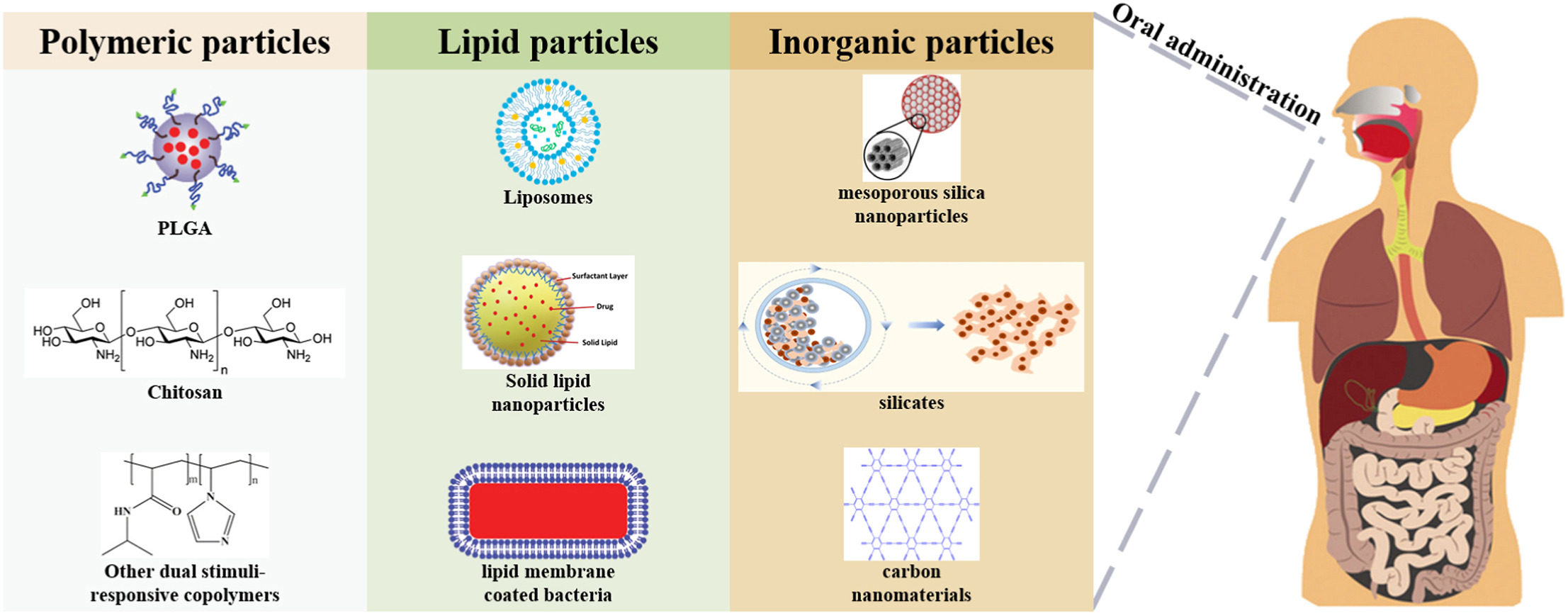Recent advances in oral drug delivery materials for targeted diagnosis or treatment of gastrointestinal diseases

Abstract
Gastrointestinal diseases offer a serious potential hazard to people’s health due to their high morbidity, mortality, and low early diagnosis rates. Due to its location within the body, the gastrointestinal tract is relatively difficult to observe and traditional endoscopy is primarily based on white light detection, resulting in a high rate of missed diagnosis. Therefore, some supplementary methods are needed to improve diagnostic accuracy. The development of probes has expanded new opportunities for the diagnosis or treatment of gastrointestinal diseases, which can deliver drugs to the lesion location through active or passive targeting. Among them, oral administration are the preferred method due to their simple administration and high patient compliance; however, they can be affected by the gastrointestinal environment, including changes in pH, obstacles of various mucus, and the effects of gastrointestinal enzymes, etc. These physiological traits also serve as the basis for designing an oral drug delivery system, which can perform precise drug delivery with these characteristics and the features of the lesion location. This review highlights the most recent developments in common oral drug delivery materials and discusses them according to material types, primarily polymeric particles, lipid particles, and inorganic particles.
Introduction
Gastrointestinal diseases are a serious concern to human health, affecting the gastrointestinal tract from the mouth to the anus. According to their symptoms, gastrointestinal diseases can be divided into two types: functional and structural. Functional gastrointestinal diseases are those in which the intestines are not functioning properly but appear normal, and structural gastrointestinal diseases are those that can be seen to be abnormal on examination and are not working properly.
Functional gastrointestinal diseases may be caused by several factors, including inadequate exercise, insufficient dietary fiber, dietary changes, excessive use of anti-diarrheal drugs, etc [38]. According to the Rome IV classification published in 2016, functional gastrointestinal disorders can be mainly divided into esophageal disorders, gastroduodenal disorders, bowel disorders, centrally mediated disorders of gastrointestinal pain, and other disorders, among which the more common are functional heartburn, functional dyspepsia, nausea and vomiting disorders, irritable bowel syndrome (IBS), etc. Globally, IBS and functional dyspepsia alone may affect 16–26% of the population [34,113].
Structural gastrointestinal diseases mainly include inflammatory bowel disease (IBD), colorectal cancer, and some diseases that require surgery. IBD is a non-infectious, chronic relapsing inflammatory disease of the gastrointestinal tract, predominantly including ulcerative colitis (UC) and Crohn’s disease (CD). A small proportion of patients have both UC and CD pathogenic characteristics, which is generally called indeterminate colitis. UC and CD show some similarities in several clinical features, such as recurrent cycles and remitting mucosal inflammation, and some extraintestinal complications. Inflammation in UC generally begins in the rectum and is limited to the colon, while CD can affect any area of the gastrointestinal tract, and it mainly affects the terminal ileum and colon [47,81]. According to epidemiological studies, in 2017, the age-standardized prevalence rate of IBD in China was 136.2 (95% UI 125.4 to 147.4) per 100,000 population [6]. The etiology of IBD is currently unclear, the prevailing view is that IBD is caused by the interaction of genetics, environmental factors, the immune system, and the gut microbiome.
Governments and individuals need to pay attention to gastrointestinal diseases, as they are highly severe public health issues that will affect the lives of many people. The first and most important thing is to advocate healthy living habits and a well-balanced diet. At the same time, early screening and diagnosis of gastrointestinal diseases are also very crucial [44,68,103]. There are many common gastrointestinal disease detection methods, such as the carbon-labeled urea breath test and rapid urease test for H. pylori [27,41,42,97], barium meal examination [132], endoscopic ultrasonography (EUS) [21,71], abdominal CT [11], stool test [40], and endoscopy [58,74], etc. Still, clinical endoscopy currently mainly adopts white light imaging technology. The disadvantage of white light imaging technology is that it has a high rate of missed detection because the lesions of many gastrointestinal diseases are subtle and difficult to identify with the naked eye. To solve this problem, a lot of research focuses on new imaging techniques, such as fluorescence imaging [13,114,125]. Fluorescently labeled probes are used to bind to receptors with specific molecular structures at the lesion site and are visualized using a dedicated light source and camera system, thereby greatly improving diagnostic accuracy.
Treatment methods for gastrointestinal diseases include clinical surgery, radiotherapy, and chemotherapy, etc. Chemotherapy is currently the most popular method. There are currently three main methods of drug delivery: intravenous injection, locoregional administration, and oral administration[ [3],_zhang_2022a,_zhang_2022b,_zhang_2022a,_zhang_2022b]. Intravenous injection is one of the main options for clinical treatment, its main advantages are high bioavailability and convenient dose control, but because drug delivery is not targeted, it often leads to systemic side effects [2,52,69]. Locoregional administration can achieve a high concentration of nanomaterials at the desired location, but it is difficult to reach many deep tissue targets, so the application scenarios are limited [51]. And oral administration has attracted more and more researchers’ attention because of its convenience, non-invasiveness, and high patient acceptance [30].
Traditional oral drugs can also cause some adverse reactions due to the systemic delivery of drugs, so current research focuses on the local delivery of oral drugs. The design idea is mainly based on the physiological conditions of the gastrointestinal tract [67,72,121], such as the degradation of enzymes or microorganisms in the gastrointestinal tract, the pH gradient in the gastrointestinal tract, the surface charge of the mucosa, the time required for drug delivery, etc, to deliver drugs to key locations [47].
The latest developments in oral drug delivery materials for the diagnosis or treatment of gastrointestinal diseases have been covered in some reviews recently [30,57,127], but no review has focused on the distinctions between different materials. Some reviews have examined the applications of oral drug delivery materials, however, the range of diseases is rather broad and not confined to gastrointestinal diseases[ [17],36,110]. Some materials may not be applicable to gastrointestinal diseases, necessitating a more specific classification. In many application scenarios, different materials each have their own advantages; for instance, metal particles are more frequently used in near-infrared (NIR) imaging. In this review, we shall categorize oral drug delivery systems according to various materials and introduce the most recent advancements in oral drug delivery materials for diagnosis or treatment of gastrointestinal diseases.
Read more here
Excipients mentioned in the paper beside others: chitosan, PLGAs, lipid nanoparticles, mesoporous silica, phospholipids
Songwei Huang, Cheng Zhou, Bensong Wang, Jinlei Jiang, Ang Gao, Jiawei Peng, Ning Tang, Shengsheng Cui, Daxiang Cui, Recent advances in oral drug delivery materials for targeted diagnosis or treatment of gastrointestinal diseases, Journal of Drug Delivery Science and Technology, 2023, 104903, ISSN 1773-2247, https://doi.org/10.1016/j.jddst.2023.104903.
Read also more on Orally Disintegrating Tablets (ODTs) here:


